Ethical Perspectives on Non-Human Animals and Human Interests
VerifiedAdded on 2021/05/31
|12
|3301
|89
Essay
AI Summary
This essay presents a philosophical discussion between three college students, Stacy, John, and James, regarding the ethics of human interaction with non-human animals. Stacy, an ecology student, initiates the debate, questioning the morality of using animals to fulfill human needs, and introduces the concept of anthropocentrism. The discussion explores various ethical viewpoints, including dark green ethics, Western ethics, and the perspectives of philosophers like Aristotle, Singer, and Leopold. The students delve into the moral standing of animals, the concept of intrinsic value, and the impact of human actions on the biotic community. They consider arguments for and against animal use, including discussions on rationality, suffering, survival, and the principle of equal consideration. The essay touches upon theories like deep ecology and Bentham's ethical theory, ultimately examining the complexities and nuances of the ethical treatment of animals in various contexts, from food production to medical experimentation, while also exploring the balance between human needs and animal welfare.
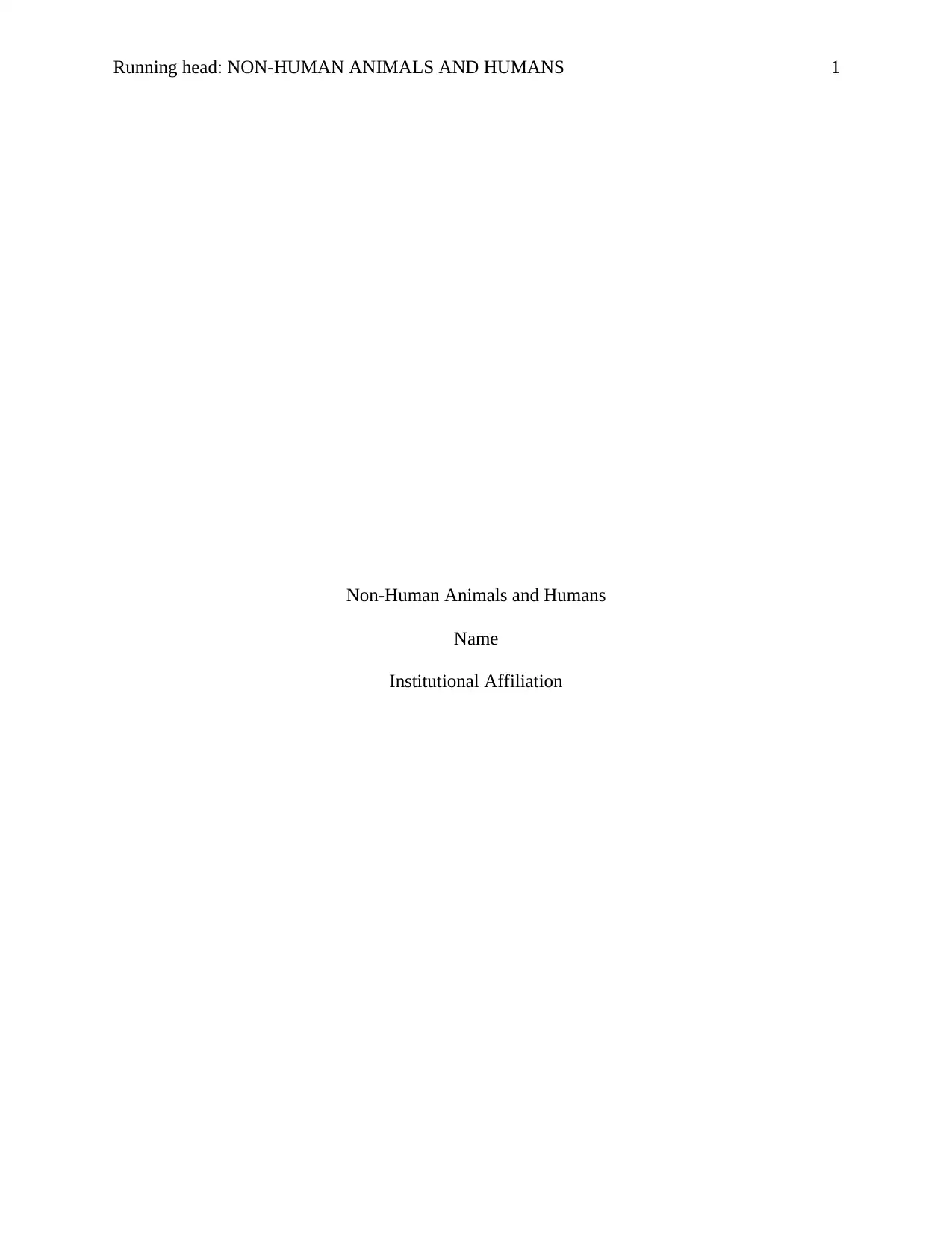
Running head: NON-HUMAN ANIMALS AND HUMANS 1
Non-Human Animals and Humans
Name
Institutional Affiliation
Non-Human Animals and Humans
Name
Institutional Affiliation
Paraphrase This Document
Need a fresh take? Get an instant paraphrase of this document with our AI Paraphraser
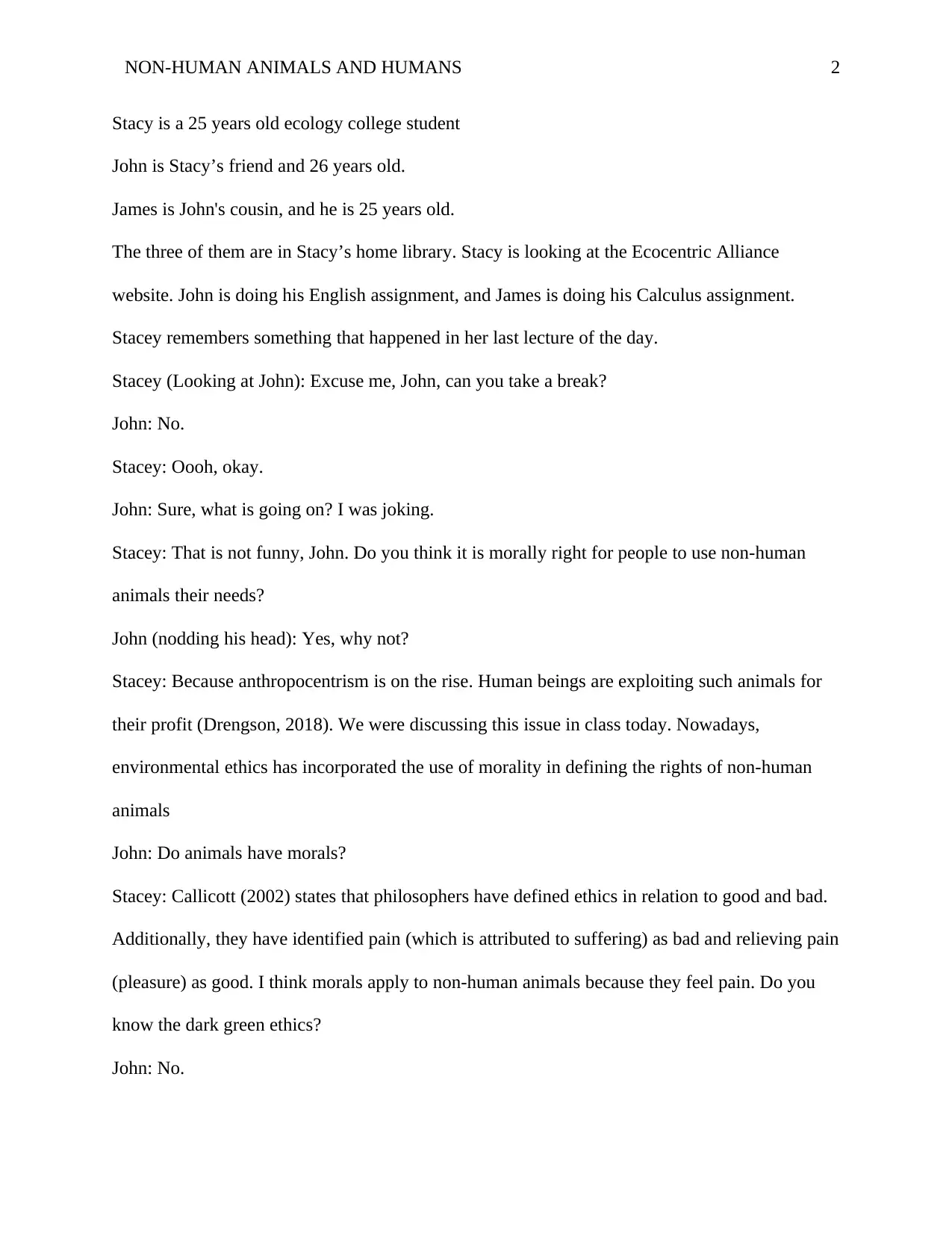
NON-HUMAN ANIMALS AND HUMANS 2
Stacy is a 25 years old ecology college student
John is Stacy’s friend and 26 years old.
James is John's cousin, and he is 25 years old.
The three of them are in Stacy’s home library. Stacy is looking at the Ecocentric Alliance
website. John is doing his English assignment, and James is doing his Calculus assignment.
Stacey remembers something that happened in her last lecture of the day.
Stacey (Looking at John): Excuse me, John, can you take a break?
John: No.
Stacey: Oooh, okay.
John: Sure, what is going on? I was joking.
Stacey: That is not funny, John. Do you think it is morally right for people to use non-human
animals their needs?
John (nodding his head): Yes, why not?
Stacey: Because anthropocentrism is on the rise. Human beings are exploiting such animals for
their profit (Drengson, 2018). We were discussing this issue in class today. Nowadays,
environmental ethics has incorporated the use of morality in defining the rights of non-human
animals
John: Do animals have morals?
Stacey: Callicott (2002) states that philosophers have defined ethics in relation to good and bad.
Additionally, they have identified pain (which is attributed to suffering) as bad and relieving pain
(pleasure) as good. I think morals apply to non-human animals because they feel pain. Do you
know the dark green ethics?
John: No.
Stacy is a 25 years old ecology college student
John is Stacy’s friend and 26 years old.
James is John's cousin, and he is 25 years old.
The three of them are in Stacy’s home library. Stacy is looking at the Ecocentric Alliance
website. John is doing his English assignment, and James is doing his Calculus assignment.
Stacey remembers something that happened in her last lecture of the day.
Stacey (Looking at John): Excuse me, John, can you take a break?
John: No.
Stacey: Oooh, okay.
John: Sure, what is going on? I was joking.
Stacey: That is not funny, John. Do you think it is morally right for people to use non-human
animals their needs?
John (nodding his head): Yes, why not?
Stacey: Because anthropocentrism is on the rise. Human beings are exploiting such animals for
their profit (Drengson, 2018). We were discussing this issue in class today. Nowadays,
environmental ethics has incorporated the use of morality in defining the rights of non-human
animals
John: Do animals have morals?
Stacey: Callicott (2002) states that philosophers have defined ethics in relation to good and bad.
Additionally, they have identified pain (which is attributed to suffering) as bad and relieving pain
(pleasure) as good. I think morals apply to non-human animals because they feel pain. Do you
know the dark green ethics?
John: No.
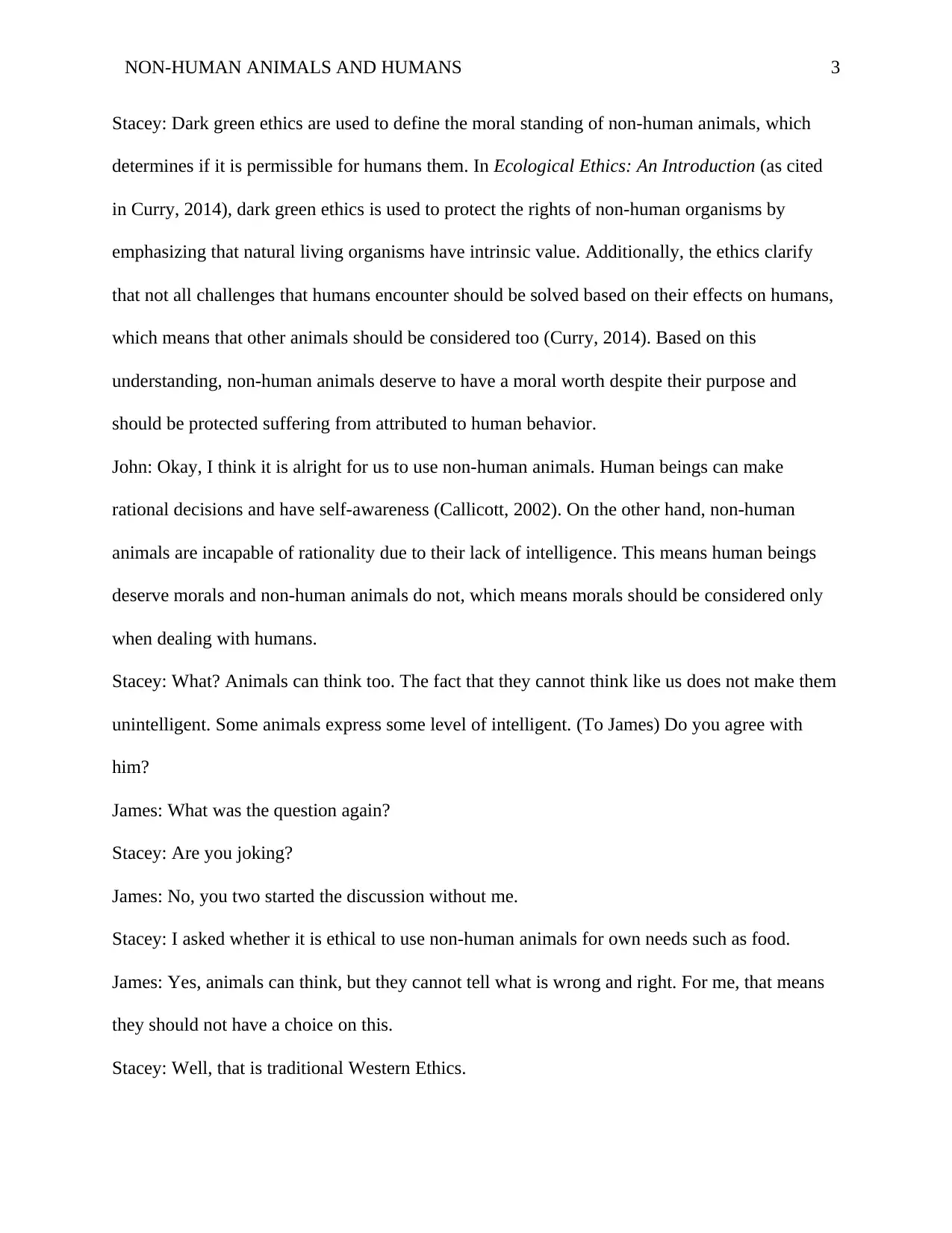
NON-HUMAN ANIMALS AND HUMANS 3
Stacey: Dark green ethics are used to define the moral standing of non-human animals, which
determines if it is permissible for humans them. In Ecological Ethics: An Introduction (as cited
in Curry, 2014), dark green ethics is used to protect the rights of non-human organisms by
emphasizing that natural living organisms have intrinsic value. Additionally, the ethics clarify
that not all challenges that humans encounter should be solved based on their effects on humans,
which means that other animals should be considered too (Curry, 2014). Based on this
understanding, non-human animals deserve to have a moral worth despite their purpose and
should be protected suffering from attributed to human behavior.
John: Okay, I think it is alright for us to use non-human animals. Human beings can make
rational decisions and have self-awareness (Callicott, 2002). On the other hand, non-human
animals are incapable of rationality due to their lack of intelligence. This means human beings
deserve morals and non-human animals do not, which means morals should be considered only
when dealing with humans.
Stacey: What? Animals can think too. The fact that they cannot think like us does not make them
unintelligent. Some animals express some level of intelligent. (To James) Do you agree with
him?
James: What was the question again?
Stacey: Are you joking?
James: No, you two started the discussion without me.
Stacey: I asked whether it is ethical to use non-human animals for own needs such as food.
James: Yes, animals can think, but they cannot tell what is wrong and right. For me, that means
they should not have a choice on this.
Stacey: Well, that is traditional Western Ethics.
Stacey: Dark green ethics are used to define the moral standing of non-human animals, which
determines if it is permissible for humans them. In Ecological Ethics: An Introduction (as cited
in Curry, 2014), dark green ethics is used to protect the rights of non-human organisms by
emphasizing that natural living organisms have intrinsic value. Additionally, the ethics clarify
that not all challenges that humans encounter should be solved based on their effects on humans,
which means that other animals should be considered too (Curry, 2014). Based on this
understanding, non-human animals deserve to have a moral worth despite their purpose and
should be protected suffering from attributed to human behavior.
John: Okay, I think it is alright for us to use non-human animals. Human beings can make
rational decisions and have self-awareness (Callicott, 2002). On the other hand, non-human
animals are incapable of rationality due to their lack of intelligence. This means human beings
deserve morals and non-human animals do not, which means morals should be considered only
when dealing with humans.
Stacey: What? Animals can think too. The fact that they cannot think like us does not make them
unintelligent. Some animals express some level of intelligent. (To James) Do you agree with
him?
James: What was the question again?
Stacey: Are you joking?
James: No, you two started the discussion without me.
Stacey: I asked whether it is ethical to use non-human animals for own needs such as food.
James: Yes, animals can think, but they cannot tell what is wrong and right. For me, that means
they should not have a choice on this.
Stacey: Well, that is traditional Western Ethics.
⊘ This is a preview!⊘
Do you want full access?
Subscribe today to unlock all pages.

Trusted by 1+ million students worldwide
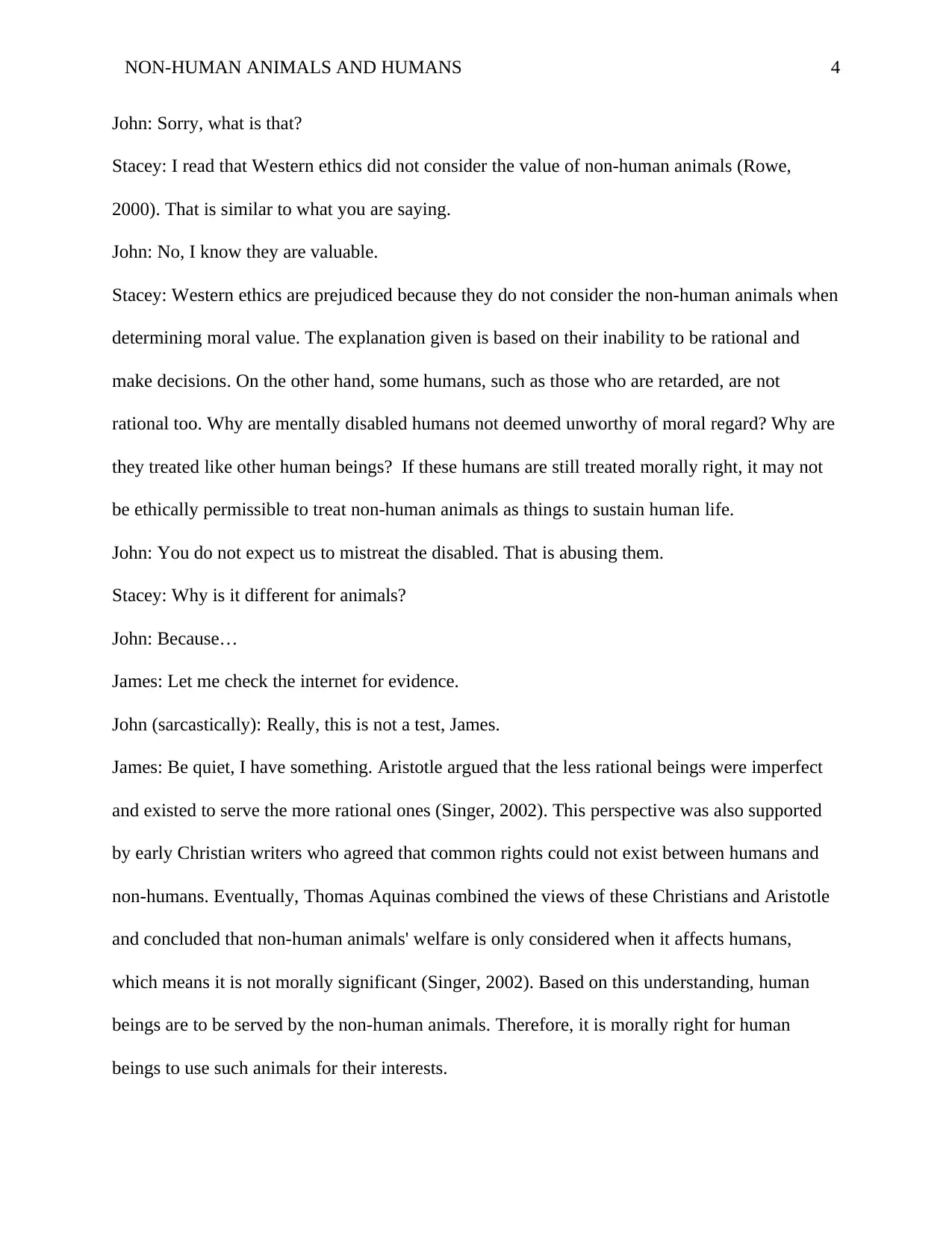
NON-HUMAN ANIMALS AND HUMANS 4
John: Sorry, what is that?
Stacey: I read that Western ethics did not consider the value of non-human animals (Rowe,
2000). That is similar to what you are saying.
John: No, I know they are valuable.
Stacey: Western ethics are prejudiced because they do not consider the non-human animals when
determining moral value. The explanation given is based on their inability to be rational and
make decisions. On the other hand, some humans, such as those who are retarded, are not
rational too. Why are mentally disabled humans not deemed unworthy of moral regard? Why are
they treated like other human beings? If these humans are still treated morally right, it may not
be ethically permissible to treat non-human animals as things to sustain human life.
John: You do not expect us to mistreat the disabled. That is abusing them.
Stacey: Why is it different for animals?
John: Because…
James: Let me check the internet for evidence.
John (sarcastically): Really, this is not a test, James.
James: Be quiet, I have something. Aristotle argued that the less rational beings were imperfect
and existed to serve the more rational ones (Singer, 2002). This perspective was also supported
by early Christian writers who agreed that common rights could not exist between humans and
non-humans. Eventually, Thomas Aquinas combined the views of these Christians and Aristotle
and concluded that non-human animals' welfare is only considered when it affects humans,
which means it is not morally significant (Singer, 2002). Based on this understanding, human
beings are to be served by the non-human animals. Therefore, it is morally right for human
beings to use such animals for their interests.
John: Sorry, what is that?
Stacey: I read that Western ethics did not consider the value of non-human animals (Rowe,
2000). That is similar to what you are saying.
John: No, I know they are valuable.
Stacey: Western ethics are prejudiced because they do not consider the non-human animals when
determining moral value. The explanation given is based on their inability to be rational and
make decisions. On the other hand, some humans, such as those who are retarded, are not
rational too. Why are mentally disabled humans not deemed unworthy of moral regard? Why are
they treated like other human beings? If these humans are still treated morally right, it may not
be ethically permissible to treat non-human animals as things to sustain human life.
John: You do not expect us to mistreat the disabled. That is abusing them.
Stacey: Why is it different for animals?
John: Because…
James: Let me check the internet for evidence.
John (sarcastically): Really, this is not a test, James.
James: Be quiet, I have something. Aristotle argued that the less rational beings were imperfect
and existed to serve the more rational ones (Singer, 2002). This perspective was also supported
by early Christian writers who agreed that common rights could not exist between humans and
non-humans. Eventually, Thomas Aquinas combined the views of these Christians and Aristotle
and concluded that non-human animals' welfare is only considered when it affects humans,
which means it is not morally significant (Singer, 2002). Based on this understanding, human
beings are to be served by the non-human animals. Therefore, it is morally right for human
beings to use such animals for their interests.
Paraphrase This Document
Need a fresh take? Get an instant paraphrase of this document with our AI Paraphraser
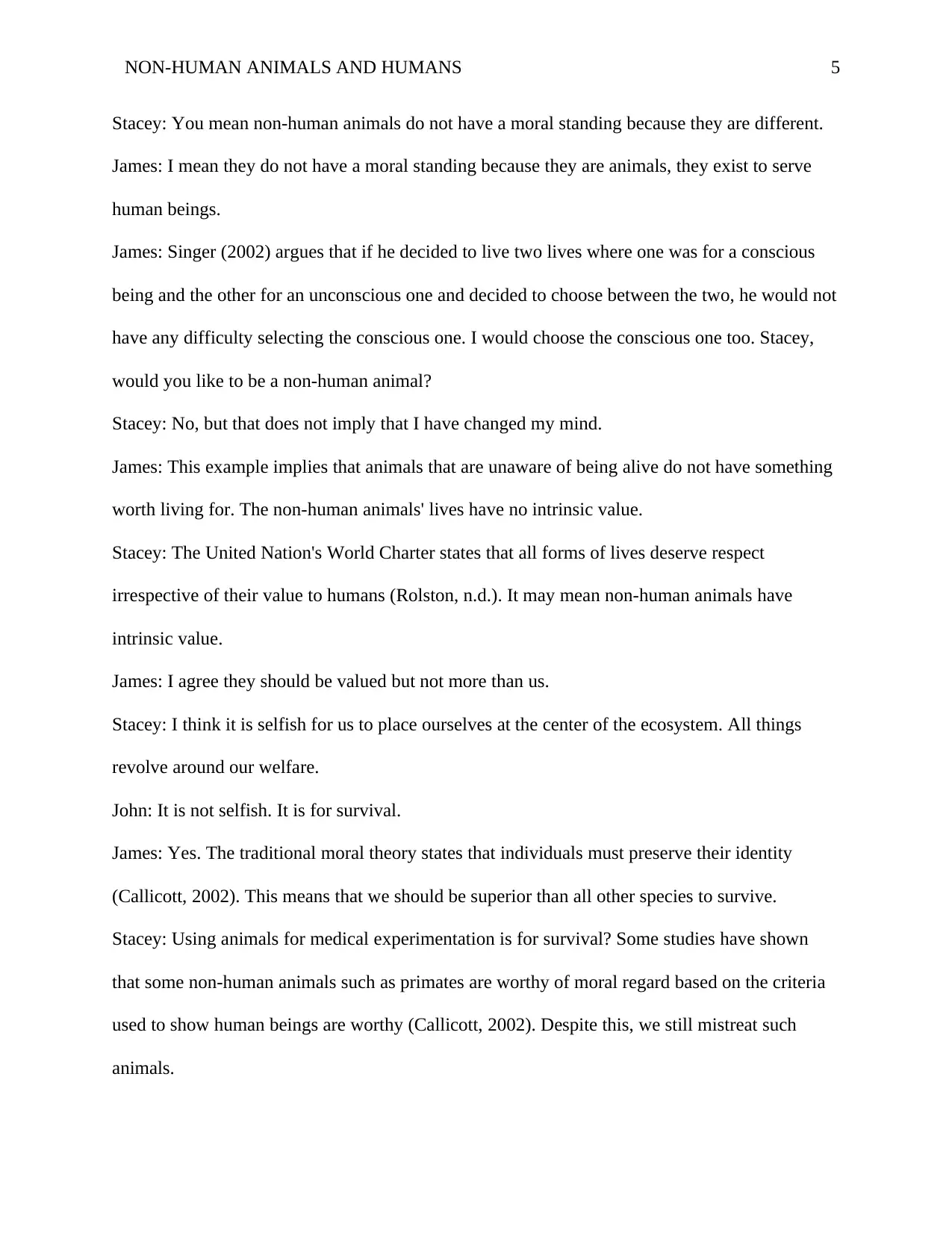
NON-HUMAN ANIMALS AND HUMANS 5
Stacey: You mean non-human animals do not have a moral standing because they are different.
James: I mean they do not have a moral standing because they are animals, they exist to serve
human beings.
James: Singer (2002) argues that if he decided to live two lives where one was for a conscious
being and the other for an unconscious one and decided to choose between the two, he would not
have any difficulty selecting the conscious one. I would choose the conscious one too. Stacey,
would you like to be a non-human animal?
Stacey: No, but that does not imply that I have changed my mind.
James: This example implies that animals that are unaware of being alive do not have something
worth living for. The non-human animals' lives have no intrinsic value.
Stacey: The United Nation's World Charter states that all forms of lives deserve respect
irrespective of their value to humans (Rolston, n.d.). It may mean non-human animals have
intrinsic value.
James: I agree they should be valued but not more than us.
Stacey: I think it is selfish for us to place ourselves at the center of the ecosystem. All things
revolve around our welfare.
John: It is not selfish. It is for survival.
James: Yes. The traditional moral theory states that individuals must preserve their identity
(Callicott, 2002). This means that we should be superior than all other species to survive.
Stacey: Using animals for medical experimentation is for survival? Some studies have shown
that some non-human animals such as primates are worthy of moral regard based on the criteria
used to show human beings are worthy (Callicott, 2002). Despite this, we still mistreat such
animals.
Stacey: You mean non-human animals do not have a moral standing because they are different.
James: I mean they do not have a moral standing because they are animals, they exist to serve
human beings.
James: Singer (2002) argues that if he decided to live two lives where one was for a conscious
being and the other for an unconscious one and decided to choose between the two, he would not
have any difficulty selecting the conscious one. I would choose the conscious one too. Stacey,
would you like to be a non-human animal?
Stacey: No, but that does not imply that I have changed my mind.
James: This example implies that animals that are unaware of being alive do not have something
worth living for. The non-human animals' lives have no intrinsic value.
Stacey: The United Nation's World Charter states that all forms of lives deserve respect
irrespective of their value to humans (Rolston, n.d.). It may mean non-human animals have
intrinsic value.
James: I agree they should be valued but not more than us.
Stacey: I think it is selfish for us to place ourselves at the center of the ecosystem. All things
revolve around our welfare.
John: It is not selfish. It is for survival.
James: Yes. The traditional moral theory states that individuals must preserve their identity
(Callicott, 2002). This means that we should be superior than all other species to survive.
Stacey: Using animals for medical experimentation is for survival? Some studies have shown
that some non-human animals such as primates are worthy of moral regard based on the criteria
used to show human beings are worthy (Callicott, 2002). Despite this, we still mistreat such
animals.
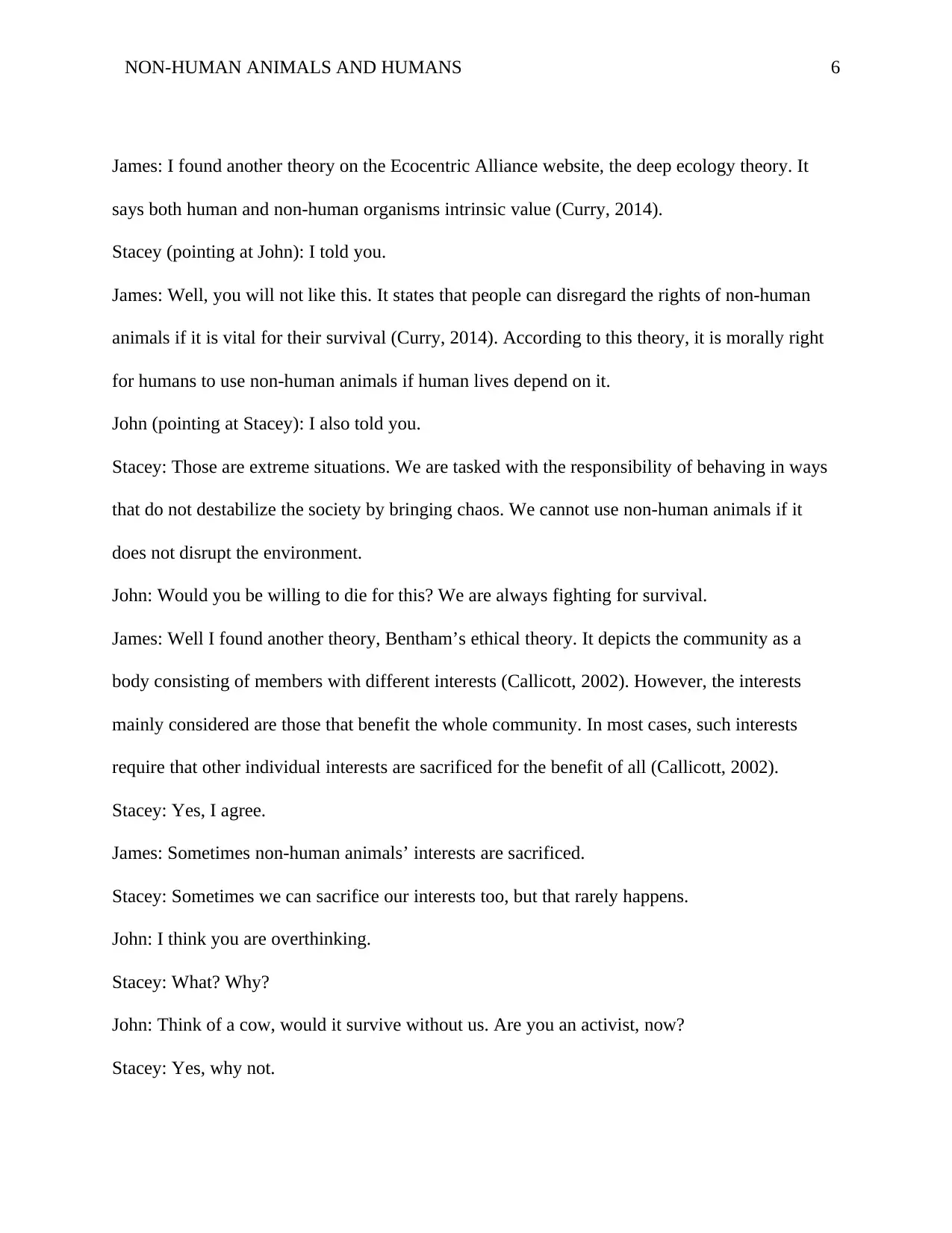
NON-HUMAN ANIMALS AND HUMANS 6
James: I found another theory on the Ecocentric Alliance website, the deep ecology theory. It
says both human and non-human organisms intrinsic value (Curry, 2014).
Stacey (pointing at John): I told you.
James: Well, you will not like this. It states that people can disregard the rights of non-human
animals if it is vital for their survival (Curry, 2014). According to this theory, it is morally right
for humans to use non-human animals if human lives depend on it.
John (pointing at Stacey): I also told you.
Stacey: Those are extreme situations. We are tasked with the responsibility of behaving in ways
that do not destabilize the society by bringing chaos. We cannot use non-human animals if it
does not disrupt the environment.
John: Would you be willing to die for this? We are always fighting for survival.
James: Well I found another theory, Bentham’s ethical theory. It depicts the community as a
body consisting of members with different interests (Callicott, 2002). However, the interests
mainly considered are those that benefit the whole community. In most cases, such interests
require that other individual interests are sacrificed for the benefit of all (Callicott, 2002).
Stacey: Yes, I agree.
James: Sometimes non-human animals’ interests are sacrificed.
Stacey: Sometimes we can sacrifice our interests too, but that rarely happens.
John: I think you are overthinking.
Stacey: What? Why?
John: Think of a cow, would it survive without us. Are you an activist, now?
Stacey: Yes, why not.
James: I found another theory on the Ecocentric Alliance website, the deep ecology theory. It
says both human and non-human organisms intrinsic value (Curry, 2014).
Stacey (pointing at John): I told you.
James: Well, you will not like this. It states that people can disregard the rights of non-human
animals if it is vital for their survival (Curry, 2014). According to this theory, it is morally right
for humans to use non-human animals if human lives depend on it.
John (pointing at Stacey): I also told you.
Stacey: Those are extreme situations. We are tasked with the responsibility of behaving in ways
that do not destabilize the society by bringing chaos. We cannot use non-human animals if it
does not disrupt the environment.
John: Would you be willing to die for this? We are always fighting for survival.
James: Well I found another theory, Bentham’s ethical theory. It depicts the community as a
body consisting of members with different interests (Callicott, 2002). However, the interests
mainly considered are those that benefit the whole community. In most cases, such interests
require that other individual interests are sacrificed for the benefit of all (Callicott, 2002).
Stacey: Yes, I agree.
James: Sometimes non-human animals’ interests are sacrificed.
Stacey: Sometimes we can sacrifice our interests too, but that rarely happens.
John: I think you are overthinking.
Stacey: What? Why?
John: Think of a cow, would it survive without us. Are you an activist, now?
Stacey: Yes, why not.
⊘ This is a preview!⊘
Do you want full access?
Subscribe today to unlock all pages.

Trusted by 1+ million students worldwide
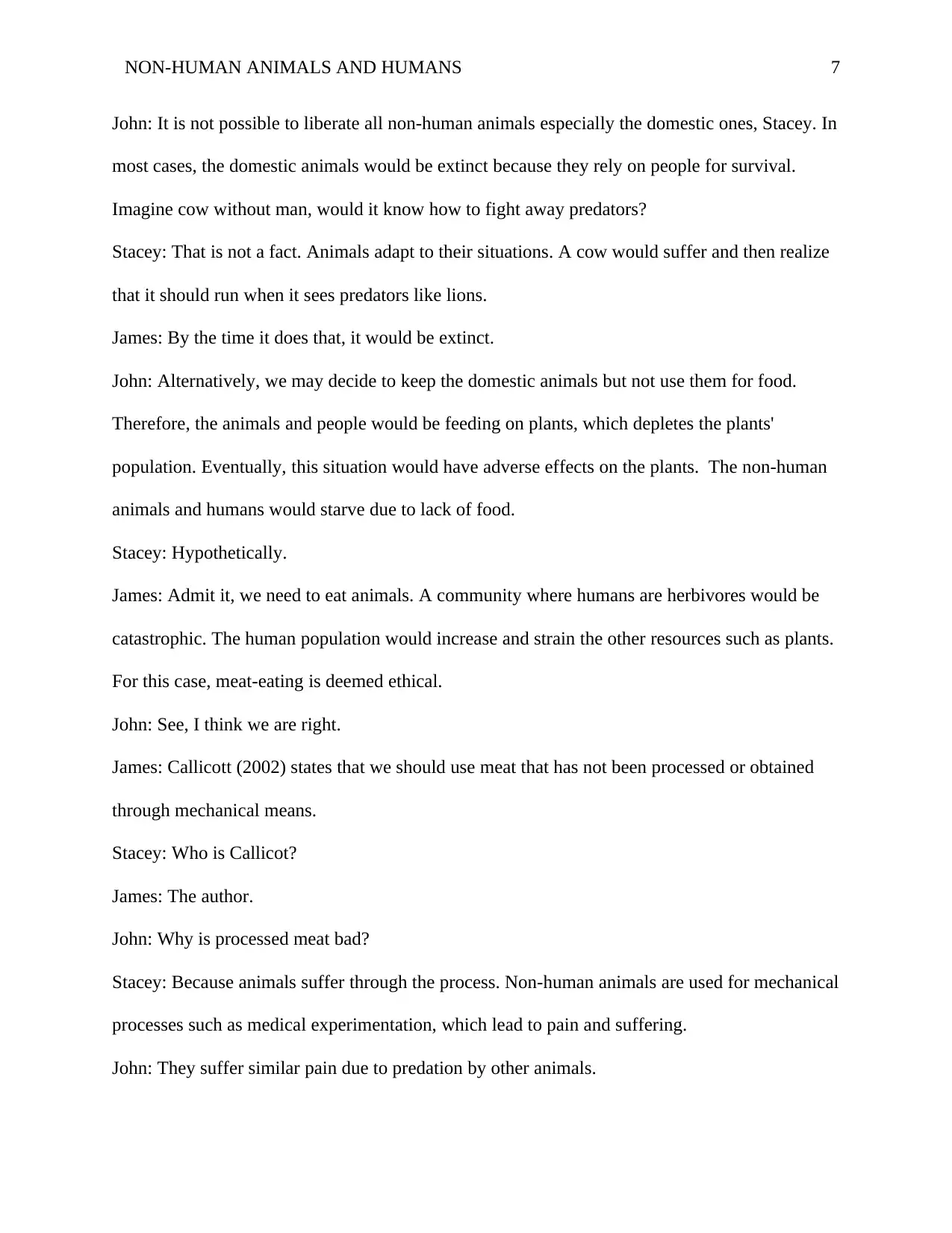
NON-HUMAN ANIMALS AND HUMANS 7
John: It is not possible to liberate all non-human animals especially the domestic ones, Stacey. In
most cases, the domestic animals would be extinct because they rely on people for survival.
Imagine cow without man, would it know how to fight away predators?
Stacey: That is not a fact. Animals adapt to their situations. A cow would suffer and then realize
that it should run when it sees predators like lions.
James: By the time it does that, it would be extinct.
John: Alternatively, we may decide to keep the domestic animals but not use them for food.
Therefore, the animals and people would be feeding on plants, which depletes the plants'
population. Eventually, this situation would have adverse effects on the plants. The non-human
animals and humans would starve due to lack of food.
Stacey: Hypothetically.
James: Admit it, we need to eat animals. A community where humans are herbivores would be
catastrophic. The human population would increase and strain the other resources such as plants.
For this case, meat-eating is deemed ethical.
John: See, I think we are right.
James: Callicott (2002) states that we should use meat that has not been processed or obtained
through mechanical means.
Stacey: Who is Callicot?
James: The author.
John: Why is processed meat bad?
Stacey: Because animals suffer through the process. Non-human animals are used for mechanical
processes such as medical experimentation, which lead to pain and suffering.
John: They suffer similar pain due to predation by other animals.
John: It is not possible to liberate all non-human animals especially the domestic ones, Stacey. In
most cases, the domestic animals would be extinct because they rely on people for survival.
Imagine cow without man, would it know how to fight away predators?
Stacey: That is not a fact. Animals adapt to their situations. A cow would suffer and then realize
that it should run when it sees predators like lions.
James: By the time it does that, it would be extinct.
John: Alternatively, we may decide to keep the domestic animals but not use them for food.
Therefore, the animals and people would be feeding on plants, which depletes the plants'
population. Eventually, this situation would have adverse effects on the plants. The non-human
animals and humans would starve due to lack of food.
Stacey: Hypothetically.
James: Admit it, we need to eat animals. A community where humans are herbivores would be
catastrophic. The human population would increase and strain the other resources such as plants.
For this case, meat-eating is deemed ethical.
John: See, I think we are right.
James: Callicott (2002) states that we should use meat that has not been processed or obtained
through mechanical means.
Stacey: Who is Callicot?
James: The author.
John: Why is processed meat bad?
Stacey: Because animals suffer through the process. Non-human animals are used for mechanical
processes such as medical experimentation, which lead to pain and suffering.
John: They suffer similar pain due to predation by other animals.
Paraphrase This Document
Need a fresh take? Get an instant paraphrase of this document with our AI Paraphraser
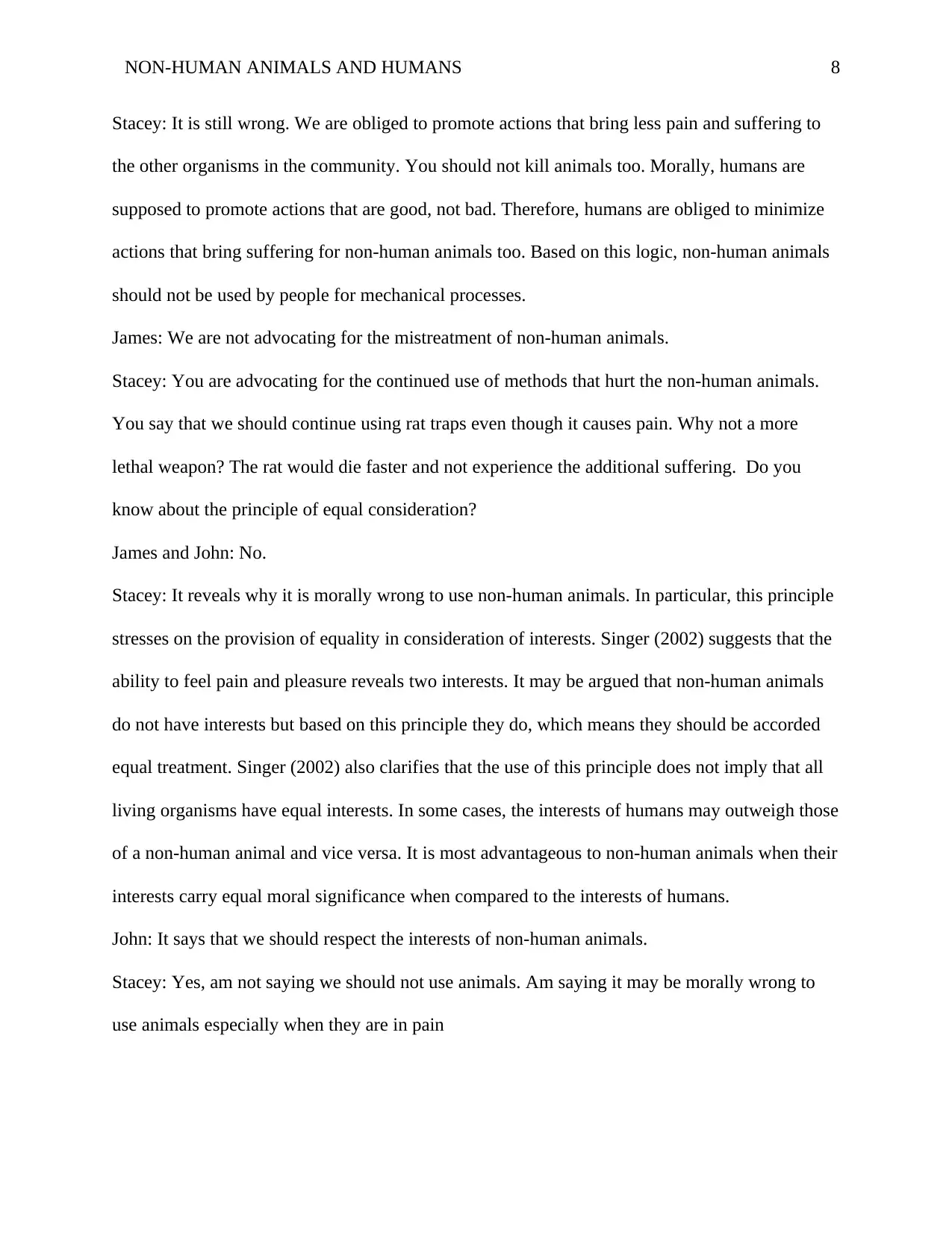
NON-HUMAN ANIMALS AND HUMANS 8
Stacey: It is still wrong. We are obliged to promote actions that bring less pain and suffering to
the other organisms in the community. You should not kill animals too. Morally, humans are
supposed to promote actions that are good, not bad. Therefore, humans are obliged to minimize
actions that bring suffering for non-human animals too. Based on this logic, non-human animals
should not be used by people for mechanical processes.
James: We are not advocating for the mistreatment of non-human animals.
Stacey: You are advocating for the continued use of methods that hurt the non-human animals.
You say that we should continue using rat traps even though it causes pain. Why not a more
lethal weapon? The rat would die faster and not experience the additional suffering. Do you
know about the principle of equal consideration?
James and John: No.
Stacey: It reveals why it is morally wrong to use non-human animals. In particular, this principle
stresses on the provision of equality in consideration of interests. Singer (2002) suggests that the
ability to feel pain and pleasure reveals two interests. It may be argued that non-human animals
do not have interests but based on this principle they do, which means they should be accorded
equal treatment. Singer (2002) also clarifies that the use of this principle does not imply that all
living organisms have equal interests. In some cases, the interests of humans may outweigh those
of a non-human animal and vice versa. It is most advantageous to non-human animals when their
interests carry equal moral significance when compared to the interests of humans.
John: It says that we should respect the interests of non-human animals.
Stacey: Yes, am not saying we should not use animals. Am saying it may be morally wrong to
use animals especially when they are in pain
Stacey: It is still wrong. We are obliged to promote actions that bring less pain and suffering to
the other organisms in the community. You should not kill animals too. Morally, humans are
supposed to promote actions that are good, not bad. Therefore, humans are obliged to minimize
actions that bring suffering for non-human animals too. Based on this logic, non-human animals
should not be used by people for mechanical processes.
James: We are not advocating for the mistreatment of non-human animals.
Stacey: You are advocating for the continued use of methods that hurt the non-human animals.
You say that we should continue using rat traps even though it causes pain. Why not a more
lethal weapon? The rat would die faster and not experience the additional suffering. Do you
know about the principle of equal consideration?
James and John: No.
Stacey: It reveals why it is morally wrong to use non-human animals. In particular, this principle
stresses on the provision of equality in consideration of interests. Singer (2002) suggests that the
ability to feel pain and pleasure reveals two interests. It may be argued that non-human animals
do not have interests but based on this principle they do, which means they should be accorded
equal treatment. Singer (2002) also clarifies that the use of this principle does not imply that all
living organisms have equal interests. In some cases, the interests of humans may outweigh those
of a non-human animal and vice versa. It is most advantageous to non-human animals when their
interests carry equal moral significance when compared to the interests of humans.
John: It says that we should respect the interests of non-human animals.
Stacey: Yes, am not saying we should not use animals. Am saying it may be morally wrong to
use animals especially when they are in pain
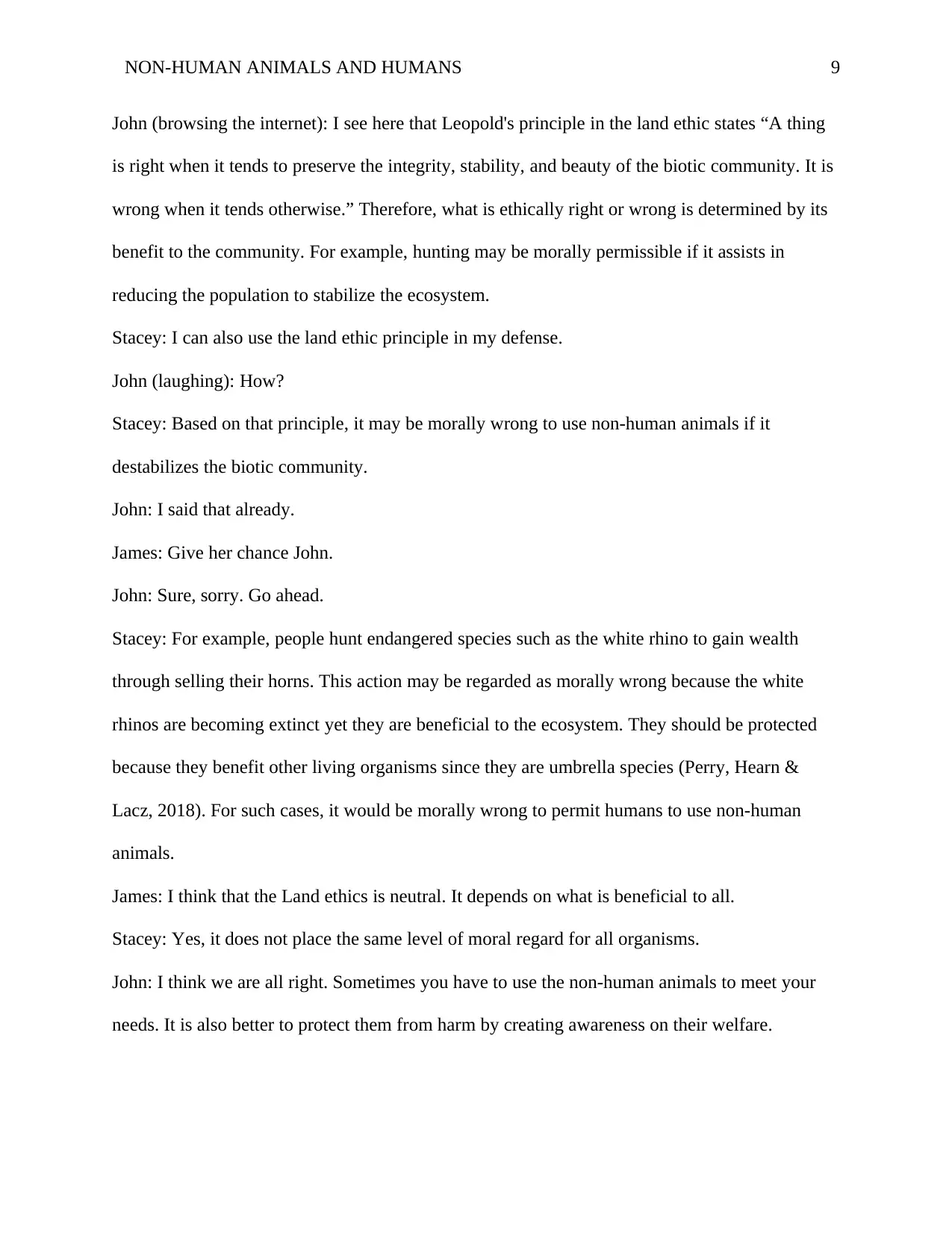
NON-HUMAN ANIMALS AND HUMANS 9
John (browsing the internet): I see here that Leopold's principle in the land ethic states “A thing
is right when it tends to preserve the integrity, stability, and beauty of the biotic community. It is
wrong when it tends otherwise.” Therefore, what is ethically right or wrong is determined by its
benefit to the community. For example, hunting may be morally permissible if it assists in
reducing the population to stabilize the ecosystem.
Stacey: I can also use the land ethic principle in my defense.
John (laughing): How?
Stacey: Based on that principle, it may be morally wrong to use non-human animals if it
destabilizes the biotic community.
John: I said that already.
James: Give her chance John.
John: Sure, sorry. Go ahead.
Stacey: For example, people hunt endangered species such as the white rhino to gain wealth
through selling their horns. This action may be regarded as morally wrong because the white
rhinos are becoming extinct yet they are beneficial to the ecosystem. They should be protected
because they benefit other living organisms since they are umbrella species (Perry, Hearn &
Lacz, 2018). For such cases, it would be morally wrong to permit humans to use non-human
animals.
James: I think that the Land ethics is neutral. It depends on what is beneficial to all.
Stacey: Yes, it does not place the same level of moral regard for all organisms.
John: I think we are all right. Sometimes you have to use the non-human animals to meet your
needs. It is also better to protect them from harm by creating awareness on their welfare.
John (browsing the internet): I see here that Leopold's principle in the land ethic states “A thing
is right when it tends to preserve the integrity, stability, and beauty of the biotic community. It is
wrong when it tends otherwise.” Therefore, what is ethically right or wrong is determined by its
benefit to the community. For example, hunting may be morally permissible if it assists in
reducing the population to stabilize the ecosystem.
Stacey: I can also use the land ethic principle in my defense.
John (laughing): How?
Stacey: Based on that principle, it may be morally wrong to use non-human animals if it
destabilizes the biotic community.
John: I said that already.
James: Give her chance John.
John: Sure, sorry. Go ahead.
Stacey: For example, people hunt endangered species such as the white rhino to gain wealth
through selling their horns. This action may be regarded as morally wrong because the white
rhinos are becoming extinct yet they are beneficial to the ecosystem. They should be protected
because they benefit other living organisms since they are umbrella species (Perry, Hearn &
Lacz, 2018). For such cases, it would be morally wrong to permit humans to use non-human
animals.
James: I think that the Land ethics is neutral. It depends on what is beneficial to all.
Stacey: Yes, it does not place the same level of moral regard for all organisms.
John: I think we are all right. Sometimes you have to use the non-human animals to meet your
needs. It is also better to protect them from harm by creating awareness on their welfare.
⊘ This is a preview!⊘
Do you want full access?
Subscribe today to unlock all pages.

Trusted by 1+ million students worldwide
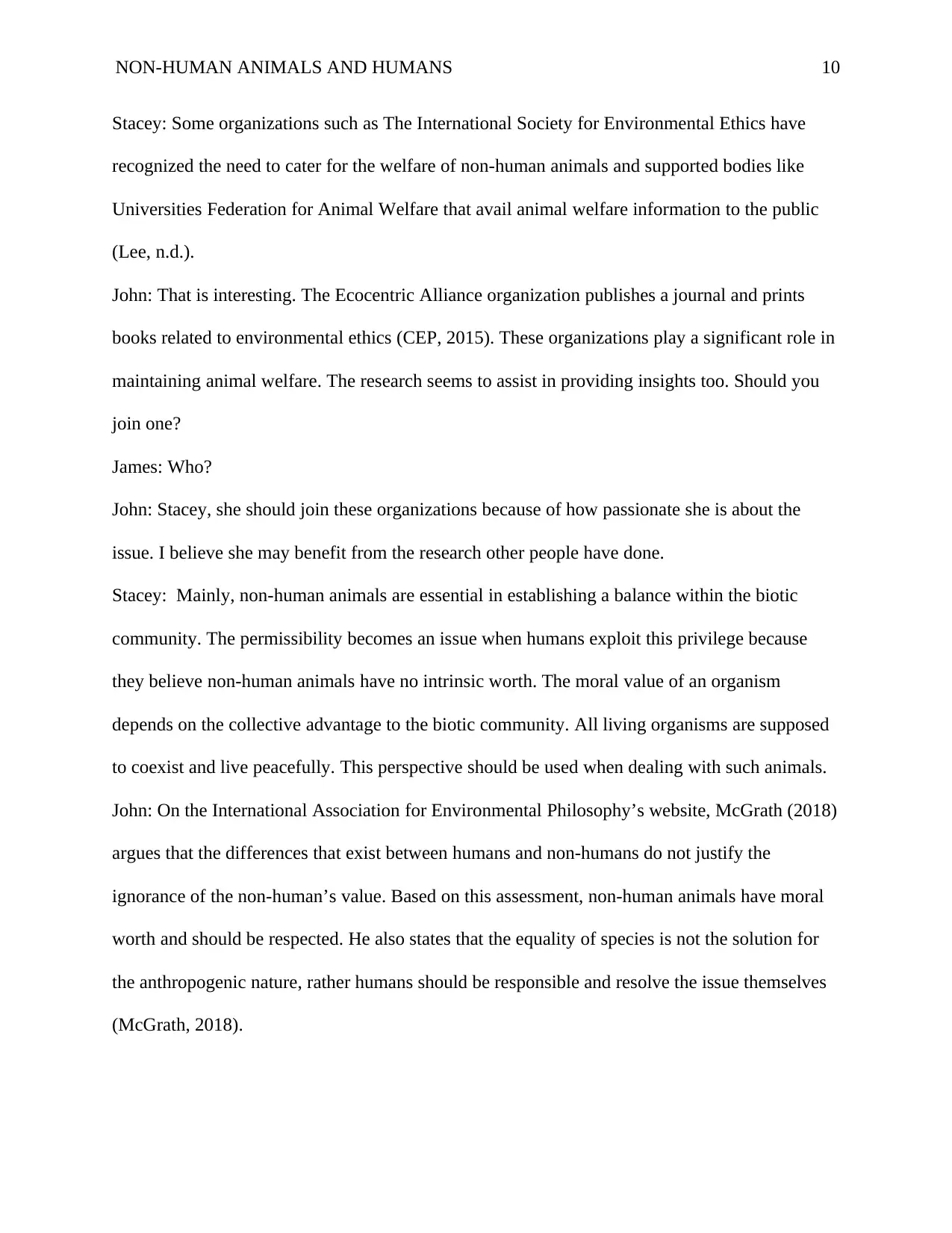
NON-HUMAN ANIMALS AND HUMANS 10
Stacey: Some organizations such as The International Society for Environmental Ethics have
recognized the need to cater for the welfare of non-human animals and supported bodies like
Universities Federation for Animal Welfare that avail animal welfare information to the public
(Lee, n.d.).
John: That is interesting. The Ecocentric Alliance organization publishes a journal and prints
books related to environmental ethics (CEP, 2015). These organizations play a significant role in
maintaining animal welfare. The research seems to assist in providing insights too. Should you
join one?
James: Who?
John: Stacey, she should join these organizations because of how passionate she is about the
issue. I believe she may benefit from the research other people have done.
Stacey: Mainly, non-human animals are essential in establishing a balance within the biotic
community. The permissibility becomes an issue when humans exploit this privilege because
they believe non-human animals have no intrinsic worth. The moral value of an organism
depends on the collective advantage to the biotic community. All living organisms are supposed
to coexist and live peacefully. This perspective should be used when dealing with such animals.
John: On the International Association for Environmental Philosophy’s website, McGrath (2018)
argues that the differences that exist between humans and non-humans do not justify the
ignorance of the non-human’s value. Based on this assessment, non-human animals have moral
worth and should be respected. He also states that the equality of species is not the solution for
the anthropogenic nature, rather humans should be responsible and resolve the issue themselves
(McGrath, 2018).
Stacey: Some organizations such as The International Society for Environmental Ethics have
recognized the need to cater for the welfare of non-human animals and supported bodies like
Universities Federation for Animal Welfare that avail animal welfare information to the public
(Lee, n.d.).
John: That is interesting. The Ecocentric Alliance organization publishes a journal and prints
books related to environmental ethics (CEP, 2015). These organizations play a significant role in
maintaining animal welfare. The research seems to assist in providing insights too. Should you
join one?
James: Who?
John: Stacey, she should join these organizations because of how passionate she is about the
issue. I believe she may benefit from the research other people have done.
Stacey: Mainly, non-human animals are essential in establishing a balance within the biotic
community. The permissibility becomes an issue when humans exploit this privilege because
they believe non-human animals have no intrinsic worth. The moral value of an organism
depends on the collective advantage to the biotic community. All living organisms are supposed
to coexist and live peacefully. This perspective should be used when dealing with such animals.
John: On the International Association for Environmental Philosophy’s website, McGrath (2018)
argues that the differences that exist between humans and non-humans do not justify the
ignorance of the non-human’s value. Based on this assessment, non-human animals have moral
worth and should be respected. He also states that the equality of species is not the solution for
the anthropogenic nature, rather humans should be responsible and resolve the issue themselves
(McGrath, 2018).
Paraphrase This Document
Need a fresh take? Get an instant paraphrase of this document with our AI Paraphraser
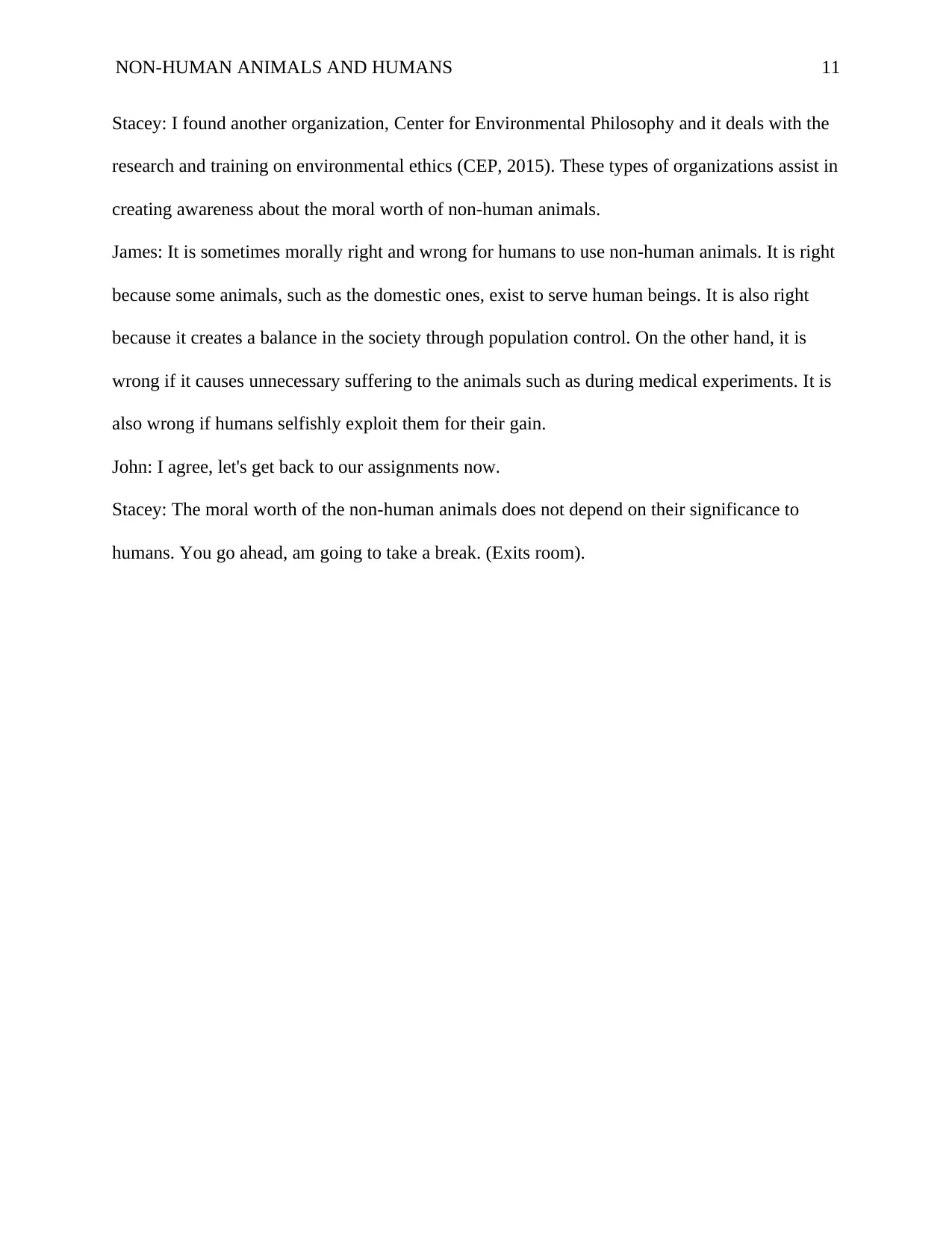
NON-HUMAN ANIMALS AND HUMANS 11
Stacey: I found another organization, Center for Environmental Philosophy and it deals with the
research and training on environmental ethics (CEP, 2015). These types of organizations assist in
creating awareness about the moral worth of non-human animals.
James: It is sometimes morally right and wrong for humans to use non-human animals. It is right
because some animals, such as the domestic ones, exist to serve human beings. It is also right
because it creates a balance in the society through population control. On the other hand, it is
wrong if it causes unnecessary suffering to the animals such as during medical experiments. It is
also wrong if humans selfishly exploit them for their gain.
John: I agree, let's get back to our assignments now.
Stacey: The moral worth of the non-human animals does not depend on their significance to
humans. You go ahead, am going to take a break. (Exits room).
Stacey: I found another organization, Center for Environmental Philosophy and it deals with the
research and training on environmental ethics (CEP, 2015). These types of organizations assist in
creating awareness about the moral worth of non-human animals.
James: It is sometimes morally right and wrong for humans to use non-human animals. It is right
because some animals, such as the domestic ones, exist to serve human beings. It is also right
because it creates a balance in the society through population control. On the other hand, it is
wrong if it causes unnecessary suffering to the animals such as during medical experiments. It is
also wrong if humans selfishly exploit them for their gain.
John: I agree, let's get back to our assignments now.
Stacey: The moral worth of the non-human animals does not depend on their significance to
humans. You go ahead, am going to take a break. (Exits room).
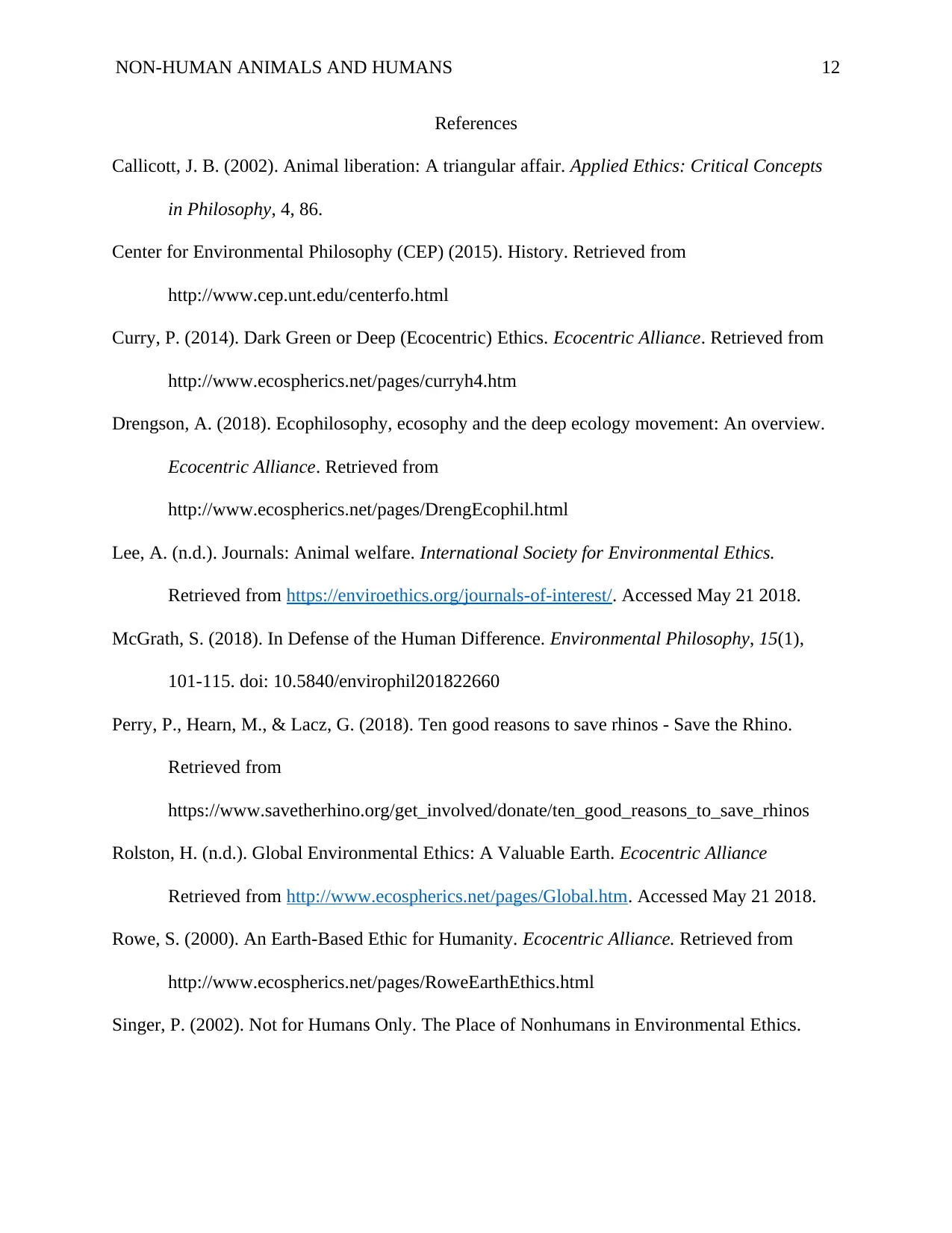
NON-HUMAN ANIMALS AND HUMANS 12
References
Callicott, J. B. (2002). Animal liberation: A triangular affair. Applied Ethics: Critical Concepts
in Philosophy, 4, 86.
Center for Environmental Philosophy (CEP) (2015). History. Retrieved from
http://www.cep.unt.edu/centerfo.html
Curry, P. (2014). Dark Green or Deep (Ecocentric) Ethics. Ecocentric Alliance. Retrieved from
http://www.ecospherics.net/pages/curryh4.htm
Drengson, A. (2018). Ecophilosophy, ecosophy and the deep ecology movement: An overview.
Ecocentric Alliance. Retrieved from
http://www.ecospherics.net/pages/DrengEcophil.html
Lee, A. (n.d.). Journals: Animal welfare. International Society for Environmental Ethics.
Retrieved from https://enviroethics.org/journals-of-interest/. Accessed May 21 2018.
McGrath, S. (2018). In Defense of the Human Difference. Environmental Philosophy, 15(1),
101-115. doi: 10.5840/envirophil201822660
Perry, P., Hearn, M., & Lacz, G. (2018). Ten good reasons to save rhinos - Save the Rhino.
Retrieved from
https://www.savetherhino.org/get_involved/donate/ten_good_reasons_to_save_rhinos
Rolston, H. (n.d.). Global Environmental Ethics: A Valuable Earth. Ecocentric Alliance
Retrieved from http://www.ecospherics.net/pages/Global.htm. Accessed May 21 2018.
Rowe, S. (2000). An Earth-Based Ethic for Humanity. Ecocentric Alliance. Retrieved from
http://www.ecospherics.net/pages/RoweEarthEthics.html
Singer, P. (2002). Not for Humans Only. The Place of Nonhumans in Environmental Ethics.
References
Callicott, J. B. (2002). Animal liberation: A triangular affair. Applied Ethics: Critical Concepts
in Philosophy, 4, 86.
Center for Environmental Philosophy (CEP) (2015). History. Retrieved from
http://www.cep.unt.edu/centerfo.html
Curry, P. (2014). Dark Green or Deep (Ecocentric) Ethics. Ecocentric Alliance. Retrieved from
http://www.ecospherics.net/pages/curryh4.htm
Drengson, A. (2018). Ecophilosophy, ecosophy and the deep ecology movement: An overview.
Ecocentric Alliance. Retrieved from
http://www.ecospherics.net/pages/DrengEcophil.html
Lee, A. (n.d.). Journals: Animal welfare. International Society for Environmental Ethics.
Retrieved from https://enviroethics.org/journals-of-interest/. Accessed May 21 2018.
McGrath, S. (2018). In Defense of the Human Difference. Environmental Philosophy, 15(1),
101-115. doi: 10.5840/envirophil201822660
Perry, P., Hearn, M., & Lacz, G. (2018). Ten good reasons to save rhinos - Save the Rhino.
Retrieved from
https://www.savetherhino.org/get_involved/donate/ten_good_reasons_to_save_rhinos
Rolston, H. (n.d.). Global Environmental Ethics: A Valuable Earth. Ecocentric Alliance
Retrieved from http://www.ecospherics.net/pages/Global.htm. Accessed May 21 2018.
Rowe, S. (2000). An Earth-Based Ethic for Humanity. Ecocentric Alliance. Retrieved from
http://www.ecospherics.net/pages/RoweEarthEthics.html
Singer, P. (2002). Not for Humans Only. The Place of Nonhumans in Environmental Ethics.
⊘ This is a preview!⊘
Do you want full access?
Subscribe today to unlock all pages.

Trusted by 1+ million students worldwide
1 out of 12
Your All-in-One AI-Powered Toolkit for Academic Success.
+13062052269
info@desklib.com
Available 24*7 on WhatsApp / Email
![[object Object]](/_next/static/media/star-bottom.7253800d.svg)
Unlock your academic potential
Copyright © 2020–2025 A2Z Services. All Rights Reserved. Developed and managed by ZUCOL.